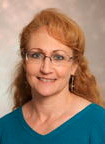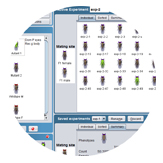 Professor Jo Handelsman
Professor Jo Handelsman
Title: Engage to Excel: A National Perspective on Science Education
Seminar Date & Time: Friday, March 16, 2012 @ 2:00 pm
View the slides from the Seminar
View the Executive Summary of the Engage to Excel Report
Professor Jo Handelsman is a Howard Hughes Medical Institute Professor in the Department of Molecular, Cellular and Developmental Biology at Yale University. Her research laboratory focuses on microbial communities within the caterpillar gut and their roles in infectious disease. As an HHMI Professor, Professor Handelsman’s education research focuses on applying the scientific methods utilized in the research laboratory to the classroom. She developed a “toolkit”, based on evidence-based studies, to improve undergraduate science education by incorporating active learning, mentoring, diversity and self-correction into the classroom.

"Engage to Excel" PCAST report to the President. Click image for the executive summary of the report.
In her inspirational seminar, Professor Handelsman spoke about her influential work serving as an expert, educational advisor to President Obama’s Council of Advisors on Science and Technology (PCAST). PCAST was recently tasked with the important goal of advising the President on improving postsecondary education. The working group compiled and presented a landmark report, Engage to Excel: Producing One Million Additional College Graduates with Degrees in Science, Technology, Engineering, and Mathematics, to President Obama.
The report first focused on the dire need to increase the number of college graduates with degrees in Science, Technology, Engineering and Mathematics (STEM). Each year in the United States, 300,000 people receive bachelor and associate degrees in STEM fields. The science and technology fields are two of the fastest growing occupations. Based on economic projections, the United States will need 1 million more individuals with backgrounds in STEM fields in the United States by 2018. This corresponds to approximately 100,000 more students who need to be trained in STEM fields each year.
In order to meet this dramatic demand for STEM individuals, the PCAST working group first investigated students currently majoring in STEM fields. The working group found that fewer than 40% of students who start college intending to major in a STEM field actually major in a STEM field. This statistic is even more dramatic when examining minority students as fewer than 20% of some ethnic groups stay in STEM fields (see Figure 1). By increasing the retention rate from just 40% to 50%, the goal of educating 1 million more students in STEM fields will be met. In addition to economic reasons, there are other reasons for changing education in STEM fields. Graduating STEM students entering the job market substantially lack conceptual and analytical thinking and exhibit poor knowledge retention; some estimates indicate that students only retain about 10-20% of a course’s content. The retention rate needs to increase in order to meet the job market demands. As a result, this issue of STEM student retention is of the utmost importance.
Prof. Handelsman and the PCAST working group discovered that both high-performing and low-performing students interested in STEM fields are leaving to pursue non-STEM fields. High-performing students are leaving due to lackluster, uninspiring introductory STEM courses and an unwelcoming atmosphere from faculty, while low-performing students are leaving due to an overarching weed-out mentality and difficulty meeting math requirements. To retain these students who are most interested in science and math, the PCAST working group put forth five recommendations (see Figure 2).
During her seminar, Professor Handelsman primarily focused on the recommendation to “catalyze widespread adoption of empirically validated teaching practices.” She discussed specific methods to incorporate “scientific teaching”, which is teaching that is approached with the same rigor as science at its best, in the classroom, particularly within introductory courses within the first two years of a student’s education. While scientific teaching has long been demonstrated to increase student learning, incorporating active learning methods in the classroom has met with resistance. Active learning methods have been demonstrated to increase learning and long-term comprehension, particularly in Physics where such methods have been implemented in a widespread fashion. Results on the Force Concept Inventory in Physics have demonstrated that students who learned with active methods have an average gain in learning that is two standard deviations above students who learned with traditional methods. In addition, traditional teaching methods can sometimes even result in “unlearning”, particularly in freshman students. To incorporate active learning in the classroom, the report focused on the following two recommendations: (1) training current and future science educators on evidence-based teaching, and (2) providing grant funding to colleges and universities to develop training programs and metrics for gauging success in STEM education.

Professor Jo Handelsman answers questions following her seminar.
Professor Handelsman also addressed the field of scientific teaching and commented on just how far the field has come since she began her career as a science educator and researcher in the early 1990’s. While faculty members and colleagues originally met her active learning methods with skepticism, she is now regularly asked about scientific teaching methods and how to incorporate them into the classroom. At Yale University, the Center for Scientific Teaching provides multiple resources for incorporating active learning methods into the classroom. Her work advising the President on science education as well as other reports, such as “Vision and Change” by AAAS and “How People Learn” by the National Research Council, garner support for active learning methods and scientific teaching. To recognize her efforts in this regard, Prof. Handelsman was awarded the Presidential Award for Excellence in Science, Mathematics and Engineering Mentoring by President Barack Obama in 2011.
Professor Handelsman strives to increase active learning in science education in many other ways. Professor Handelsman is the co-Director of the National Academies Summer Institute for Undergraduate Education in Biology, which aids other faculty and teachers in their quest to develop their teaching methods. The Summer Institute leads an annual week-long training session that focuses on teaching faculty how to incorporate active learning methods into their own classroom. Professor Handelsman also co-founded the Women in Science and Engineering Leadership Institute at the University of Wisconsin at Madison to increase the participation of women and minorities in science.





